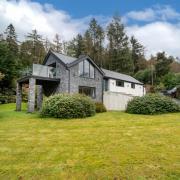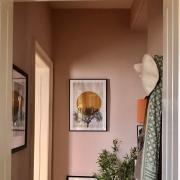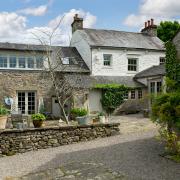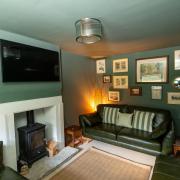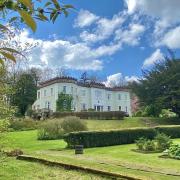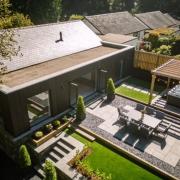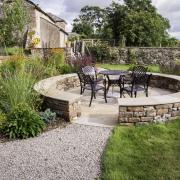Amid the melee and hubbub of this year’s RHS Chelsea Flower Show was a corner of calm. Sanctum was a show garden that offered “an oasis amid the chaos of contemporary life”.
It was designed by Sonja Kalkschmidt and most of the plants came from here in Cumbria, grown and supplied by Abi & Tom’s Garden Plants at Halecat. Needless to say, it won a coveted gold medal, a triumph for Sonja and Cumbria Life’s own Tom Attwood who grew the plants.
Back in the South Lakes, as the bees battle for the best nectar in poppies and the breeze rustles through the many trees that punctuate the nursery, it is pleasing to think that some of the real tranquillity here contributed to a sense of peace in inner London even if only for the week-long show.

The road to get there, however, was anything but calm; the anxiety that is always etched on the faces of Chelsea garden designers during television interviews reflects what a stressful experience it can be.
For Tom making his show debut as plant supplier and Sonja also entering her first Chelsea – a chance to mark her 50th birthday with a memorable and exciting challenge – the pressure was on.
“Years ago I went to Chelsea with Newton Rigg College and five or six years ago my friend Charlie Whinney asked me to do a planted area for his stand at the show, which was good practice because it wasn’t judged and was very painless. But this was different,” explains Tom.

Sonja first heard of Tom at her first ever professional show garden, at Belvoir Castle, in Leicestershire. “It was a week after I graduated. I met Mr Hardy, of Hardy Plants, and he said, ‘If I ever did a show garden I would want to work with Tom Attwood’. I thought, ‘Who is this guy?’.
“With Chelsea I really needed help looking for plants that I wasn’t as familiar with, and Tom and Abi are also local,” explains Sonja, who lives at Low Bentham, just 23 miles from Halecat across the border into North Yorkshire.
Sonja’s career has seen her transition from architecture to garden design in a natural evolution. Through her background she developed an appreciation for the interaction between buildings and the natural landscape, and the people who interact in these spaces. It guided her to garden design, where she could explore the balance between the rigid structures of architecture and the fluid, ever-changing world of plants.

Her Chelsea garden was in the container category so plants could only be in containers in the three by four metre space. Sanctum was designed for “a corporate setting in London lacking sunlight that would offer a sanctuary to employees to rejuvenate from technology and connect with nature, emphasising mental health and well-being in the workplace”.
It was created to be a tranquil refuge, a space in which to escape from what can feel like the relentless digital overload and hectic pace of corporate life. It highlighted the importance of incorporating natural elements into corporate environments for a more balanced, health-conscious work atmosphere and reflected Sonja’s interest in how plants can soften the harsh lines of buildings.
Built by Rupert Crowton Rowarth with construction consultant Gareth Wilson, the garden featured a striking black charred wood pod at its centre creating a visual contrast with lush foliage.
The wood, which was thermally treated without chemicals, originated from the fast-growing Monterey pine (Radiata pine) chosen for its very high durability. Sonja charred, brushed, cleaned and oiled all 400 pieces of timber herself. “Our entire house and garage were taken over by this Chelsea venture,” she recalls.

She worked closely with the joiners Glen and Jack Copeland to assemble the timber structure.
The planting was selected for texture and a rich variety of green tones with occasional hints of subdued colour and white; plants that would provide structure and form by their leaves and stems.
“It was subtlety of planting,” says Tom. “It was less about flower power and there were some colours that were not to be a part of it. It was essentially woodland planting using hardy perennials and shrubs that grow in Cumbria.
“That was really important and I think it came across in the final results. There was a beautiful subtlety through the whole garden that definitely appealed to me.”

Of course, this was Chelsea and as possibly the world’s most famous garden show it was not as simple as simply choosing plants that fitted the overall look Sonja wanted to achieve.
Tom explains: “It is not just the aesthetics that have to look good at Chelsea, there is a whole series of criteria and caveats that have to be met to ensure the planting is true to the garden.
“You have to use plants that are appropriate to the setting, in this case a shaded city space lacking sunlight, but you also have to consider soil type, moisture content and so on because the judges really pick up on that if they think you have gone off-piste.
“It was a combination of working with the plants that would look good and meet Sonja’s vision, but also that met the criteria. As a designer Sonja is creative and knows what she likes the look of, but she readily admits she has more to learn about plants and needed guidance. All we do is live and breathe plants so we worked well together.”

Although the space is small, planting for Chelsea is not like planting at home where plants are typically given space in which to grow and mature.
“At Chelsea you need density of planting to give the effect of maturity so you plant multiples of things and that’s where we’ve got experience,” says Tom.
“You also have to think about different levels, so plants that will give height and others that will be at a lower level. It needs a scary number of plants. We used around 250 which was a third of what we grew.”
An ideal plant combining green with white flowers is Anemone virginiana – “perfect for height and subtlety,” says Tom. He also introduced Sonja to Actaea ‘Misty Blue’. “It was one of those plants she didn’t know about, but its almost metallic blue worked really well in a palette of green and against the charred black frame; everything looks good against black,” he adds.

Polygonatum verticillatum ‘Rubrum’ was another of Sonja’s favourites. “I had heard of it but it was never on my radar. That, and Astilboides tabularis, I now love so much that I’m planting them in my own garden,” she says.
Another plant offering a contrast of colour was Athurhium Okanum fern with a drop of red on the tips of its leaves.
“Sonja said at the beginning that it’s nice to have unusual things as well as the staples and that’s where we can help because we grow a lot of what is widely available but also, being an independent nursery, we have an unusual batch of plants that many people haven’t come across. It’s one of the reasons Sonja wanted to work with us,” says Tom.
Additional pressure came from ensuring each plant was in optimum condition for the show, which included Tom taking some of the sensitive ferns home from the nursery and keeping them in the bathroom whenever frost was forecast.

Sonja says: “By the garden being based on foliage we could get away with things not being quite in bloom, and I like things in bud. However, with such large leaf plants you have to be so careful not to have any holes in the leaves. If there is just one hole you just can’t use it.”
Tom continues: “You have to grow far more plants than you will ever need so that you have the luxury of being able to choose the very best candidates. And because we had so many plants we also needed to create a dedicated space to store them to maintain the best possible conditions. You can whack everything in a polytunnel, but it will go berserk and be too tall or too lush.
“We’ve always got the challenge of what the weather and elements are doing. This spring was wet, there were late frosts and then it was really warm. When you’re driving for perfection there’s no margin for error, so it’s a challenge.”
Sonja recalls “one of the best days” of the Chelsea experience was visiting nurseries in London with Tom in her Mini to pick up a few additional plants. “I made the classic mistake of having lots of plants but not enough of a few of them,” she admits.

“We needed three or four times what you might think of certain plants. You can’t put two or three of a certain plant in a Chelsea garden, even a small one. We needed 12 Rodgersia so it was very funny coming back in my Mini with Tom totally covered in them.”
Growing the plants is, of course, one thing; all those grown in Cumbria had to be transported to the show, which is created every year in the grounds of Chelsea Hospital, in London.
It meant hiring a large Luton box van and borrowing plant trollies from another nursery. “Driving it through London was a terrifying thought,” says Tom, “but it was OK but negotiating the showground was something else. It is a miracle what they manage to do there.
“It is a one in-one out system and you’re given a time slot to get in. Then it was 90 minutes to get from the entrance to where we needed to be and you were driving between stands and people with only inches to spare on either side. Everyone is very stressed, but the marshals are amazing and help you get through. It was just relief that I didn’t knock into anyone.”

It was a proud moment to achieve gold – “it’s what everybody wants,” says Tom – but with characteristic modesty he adds: “It was Sonja’s first show garden and she was financing the whole thing herself so there was a lot of pressure on her. I am pleased for her and delighted that we got a chance to be involved. It was fraught towards the end, but the end result was great.
“The structure of the design and the framing of the planting looked so well and the combination between that and a beautiful, lush, repeating pattern of plant forms just nailed it really.”
Sonja says: “It was a huge surprise to get gold. I never expected it, I just really tried to focus on doing the best I could. It’s quite unusual to start with Chelsea. I declined a few others last year saying I wanted to save my energy for Chelsea, but it was a team effort.
“I had a fantastic team. They were really competitive, thriving people. It was Tom who kept me grounded, calm and on track who calmed me down, which I was so thankful for.”

A particular highlight for Sonja was to receive a visit from King Charles. “He unexpectedly stopped at the garden and shook my hand. I thought, ‘there just isn’t a better way of approval, I was over the moon. Princess Beatrice also came to visit and sat in the garden; she is such a warm and friendly person.
“I really appreciated that the Royals came to see the smaller garden categories this year, it makes such a difference. Not everyone can afford large gardens and it gives more relevance to smaller gardens, which are, in my view, much harder to design; there is nowhere to hide in the detailing.”
With the gold medal achieved, there was time to see the rest of the show. “One of the real bonuses was getting to see all the other gardens being built, the luxury of the space to ourselves and meeting the people working on them,” says Tom.
“In our own garden Sonja had gathered a really nice bunch of volunteers and another designer from Germany, which made for an eclectic mix of people. You’re all in this very tense sort of environment together.”
When their daughters, Esther and Rowan, are a little older, Tom hopes that Abi & Tom’s Garden Plants can have a stand at Chelsea. “I’d like Abi to have the chance because she’s so good at what she does, she deserves it,” he says.
Their two-acre garden has constantly developed and evolved as the couple have tamed and cultivated the land, which has kept customers coming. They also own Grange Plant Centre With Abi & Tom, at Grange-over-Sands.
“We love our regulars,” says Tom, “but when we get new visitors who have lived in, say, Ulverston for 25 years who come for the first time and say they can’t believe what they find, that’s really rewarding. The comment that really, really makes us happy is when they say it’s like walking around someone’s garden. That’s what we what it to be and as each year goes by that gets easier. It’s really important when people walk in that there is plenty of choice.”
He adds: “One of the things about going away to somewhere like London is that it gives you some distance, perspective. Stepping outside your comfort zone is a healthy thing but I was ready to scamper back to Halecat. You get back here and think what we have is lovely.”
abiandtom.co.uk
@abiandtomsgardenplants
kalkschmidt.co.uk
@silva_barns
MORE FROM SONJA AND TOM’S SANCTUM PLANT LIST
Acer palmatum
Actaea simplex 'Black Negligee'
Actaea simplex ‘Misty Blue’
Astilboides tabularis
Anemone stolonifera
Anemone virginiana
Anemonella thalictroides
Blechnum spicant
Carex Ribbon Falls
Digitalis purpurea 'Alba'
Disporopsis pernyi
Dryopteris erythrosora
Drypoteris filix-mas
Dryopteris wallichiana
Epimedium x rubrum
Epimedium x warleyense 'Orange-Queen'
Epimedium niveum
Fragaria vesca
Geum rivale 'Album'
Hosta 'Devon Green'
Hosta 'Krossa Regal'
Hosta ‘Purple Heart’
Hydrangea Quercifolia
Matteuccia struthiopteris
Polygonatum verticillatum ‘Rubrum’
Polystichum aculeatum
Polystichum setiferum 'Plumosum Densum'
Rodgersia p. 'Chocolate Wing'
Rosa banksiae var. banksiae
Tellima grandiflora
Tiarella 'Spring Symphony'
Sonja’s tips for container gardens
• Use the largest planters you can get to retain moisture.
• Larger planters allow the freedom to use larger or trees that give instant impact and volume.
• Attach vertical structures to planters to provide height for climbers.







